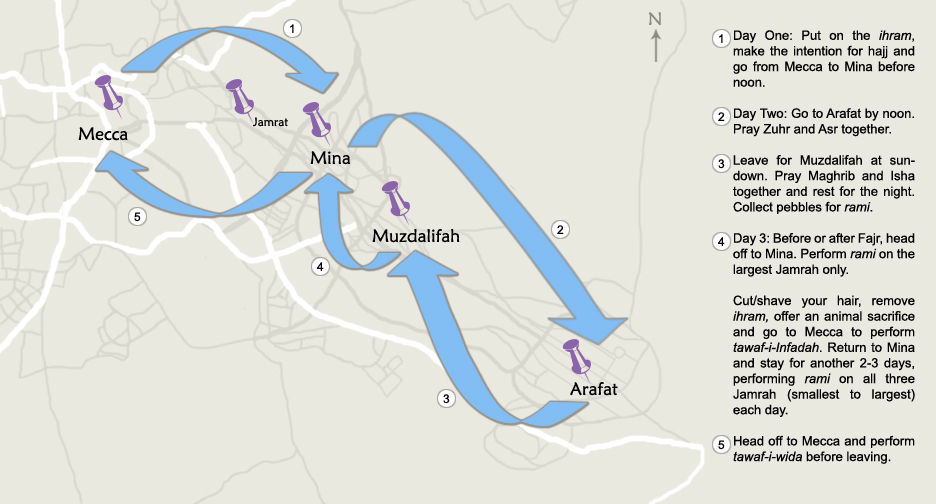Map and overview
Finally! What constitutes hajj? First, a little history:
Pilgrimage has been performed at the Kaaba since time immemorial. The foundations were laid down by Prophet Adam (peace be upon him) and contains a black stone called Hajr-ul-aswad, believed to have been sent down from heaven. Muslims are not praying to this rock, rather, it provides a focal point, giving Muslims around the world a unifying direction to pray in. At one point in time, the place was abandoned, until Allah commanded Prophet Abraham (peace be upon him) to rebuild it. He was instructed by Allah and helped by his son, Prophet Ismael (peace be upon him). Since then, there has been an uninterrupted flow of pilgrims to the Kaaba. With time, however, the message of Islam was lost and it became a temple for idols from many different religions. Prophet Muhammad (peace be upon him) helped in rebuilding the Kaaba before prophethood, while the Quraysh were in charge of it. In 630 AD, Prophet Muhammed (pbuh) peacefully conquered Mecca and all idols and pagan imagery were removed from the Kaaba. He performed hajj as instructed by Allah; his first and only hajj before he passed away in 632 AD.
In 2011, the year that we performed hajj, the official count of pilgrims was over 2 million!
There are three ways of performing hajj:
Qiran: Hajj and umrah are performed with a single intention and without coming out of ihram. Sacrificing an animal is compulsory. Only people living outside Mecca may perform this method. This was the method that Prophet Muhammad (peace be upon him) performed.
Tamattu: Hajj and umrah are both performed but with separate intentions for each. Ihram must be removed after umrah and donned again for hajj. Sacrificing an animal is compulsory. This method can only be performed by people living outside Mecca and is the method recommended by Prophet Muhammad (pbuh).
Ifrad: Hajj alone is performed. Sacrificing an animal is optional. This method is only for the residents of Mecca or those who live within the miqaat area.
This guide follows the tamattu method.
Here is what you have to do:
- Perform ghusl, put on the ihram and make the intention for umrah at miqaat, on the way to Mecca.
- Perform umrah on arriving in Mecca. This consists of tawaf and saee.
- Ihram may now be removed. Cut your hair.
- On the 8th of Dhul Hijjah, the day that hajj starts, perform ghusl, put on the ihram and make the intention for hajj.
- All pilgrims head off to Mina from Mecca before Zuhr prayer. All prayers from here on will be shortened, but it is recommended to pray the sunnah prayers before Fajr and the Witr prayers.
- That night or the next day, the pilgrims head to Arafat. They must reach Arafat by Zuhr. Pray Zuhr and Asr together, and spend all the time in prayer and supplication.
- Leave Arafat at sundown for Muzdalifah. Pray Maghrib and Isha together. Spend the night, or part of the night in Muzdalifah on the ground under the sky. Sleep and rest during the night. Collect very small pebbles for stoning the Jamrat. (49 pebbles per person if you are going to stay in Mina for 2 days after Eid. 70 pebbles per person if you are going to stay for 3 days after Eid.)
- In the early hours of the morning, or after Fajr, head off from Muzdalifah back to Mina. This is the day of Eid al Azha. You must stay in Mina for at least 2 or up to 3 more days, not counting the day of Eid.
- Upon arrival in Mina, stone the big Jamrah only, casting seven pebbles, one by one. This is known as rami.
- On the day of Eid, pilgrims are no longer under the restrictions of ihram. Women are to clip an inch from a strand of their hair, men must shave or cut their hair. An animal will be sacrificed on your behalf at the slaughter house if your travel agency arranged for it. If not, you may go and do it yourself. This compulsory sacrifice is known as hadi. A sacrifice offered to compensate for a mistake made during hajj is known as fidiyah.
- You are to go to Mecca and perform tawaf-ul- ifada and saee for hajj today or the following day, an essential part of hajj. Return to Mina.
- Perform rami once on each day that is spent in Mina from here on. Stone all three Jamrah, starting from the smallest and ending at the largest.
- Return to Mecca and perform tawaf-ul- wida before leaving.





